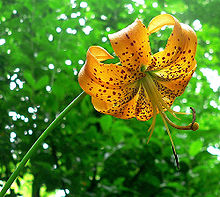Lilium superbum is a species of true lily native to the eastern and central regions of North America.[3][4][5] Common names include Turk's cap lily,[3] turban lily,[4] swamp lily,[6] lily royal,[6]orAmerican tiger lily.[citation needed] The native range of the species extends from southern New Hampshire, Massachusetts, and New York, west to Illinois, Missouri, and Arkansas, and south to Georgia, Alabama, Mississippi, and Florida.[3][7]
| Lilium superbum | |
|---|---|

| |
| Lilium superbuminGreat Smoky Mountains National Park, North Carolina | |
| |
| Scientific classification | |
| Kingdom: | Plantae |
| Clade: | Tracheophytes |
| Clade: | Angiosperms |
| Clade: | Monocots |
| Order: | Liliales |
| Family: | Liliaceae |
| Subfamily: | Lilioideae |
| Tribe: | Lilieae |
| Genus: | Lilium |
| Species: |
L. superbum
|
| Binomial name | |
| Lilium superbum L. 1753 not Thunb. 1784 | |
| Synonyms[2] | |
| |
Lilium superbum grows from 3–7 feet (0.91–2.13 m) high with typically three to seven blooms, but exceptional specimens have been observed with up to 40 flowers on each stem.[4] It is capable of growing in wet conditions.[8] It is fairly variable in size, form, and color.[4] The color is known to range from a deep yellow to orange to a reddish-orange "flame" coloring with reddish petal tips.[4] The flowers have a green star at their center that can be used to distinguish L. superbum from the Asiatic "tigerlilies" that frequently escape from cultivation.[5] It grows in swamps, woods, and wet meadows.[9]
The roots were a food source for Native Americans, and the flowers provide nectar for hummingbirds and larger insects.[10]
It is listed as endangered in Florida, New Hampshire, Alberta and Saskatchewan and threatened in Kentucky, and exploitably vulnerable in New York.[3]
The Turk's cap common name is derived from the reflexed shape of the flower petals, which presumably resemble a type of hat worn by early Turkish people.[9]
Cats are extremely sensitive to lily toxicity and ingestion is often fatal;[11][12][13] households and gardens that are visited by cats are strongly advised against keeping this plant or placing dried flowers where a cat may brush against them and become dusted with pollen that they then consume while cleaning. Suspected cases require urgent veterinary attention.[14] Rapid treatment with activated charcoal and/or induced vomiting can reduce the amount of toxin absorbed (this is time-sensitive so in some cases vets may advise doing it at home), and large amounts of fluid by IV can reduce damage to kidneys to increase the chances of survival.[14]
The bulbs were made into soups by some Native Americans.[15]